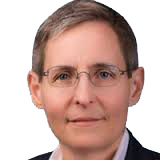Speaker's Biographies & Abstracts

Dr. Kimball is responsible for leading the Nation's largest water, earth, and biological science, and civilian mapping agency.
Prior to becoming the Director, Dr. Kimball was the USGS Deputy Director. In 2008, she became the Associate Director for Geology, and prior to that was the Director of the USGS Eastern Region, starting in 2004. She joined the USGS as Eastern Regional Executive for Biology. In that position, she built many partnerships, helped shape programs, and led the establishment of the USGS Florida Integrated Science Center. She came to the USGS from the National Park Service in Atlanta, where she was Associate Regional Director.
She entered the National Park Service as a research coordinator in the Global Climate Change Program, became Southeast Regional Chief Scientist, and then Associate Regional Director. She was assistant professor of environmental sciences at the University of Virginia, co-director of the Center for Coastal Management and Policy and marine scientist at the Virginia Institute of Marine Science, and managed coastal morphology and barrier island studies in the U.S. Army Corps of Engineers.
She serves on executive boards and many State and national committees, including the Consortium for Coastal Restoration through Science & Technology, the Council of Examiners of the National Association of State Boards of Geology, and the DOI Senior Executive Service Advisory Council. She was on the board of directors of the Coastal Society and has served as secretary of the American Geophysical Union's Ocean Sciences Section.
She has authored numerous publications on barrier island dynamics, coastal ecosystem science, coastal zone management and policy, and natural resource exploration, evaluation, and management. She has received the Presidential Rank Award and the Secretary of the Interior's Meritorious Service Award.
Dr. Kimball has a doctorate in environmental sciences with a specialty in coastal processes from the University of Virginia, a master's in geology and geophysics from Ball State University, and a bachelor's in English and geology from the College of William & Mary.

Bryn Fosburgh joined Trimble in 1994 as a technical service manager for surveying, mining, and construction. In 1997, he was appointed director of development for the company's land survey business unit where he oversaw the development of field and office software that enabled the interoperability of Trimble survey products. Over the past 21 years, he has held numerous roles, including Vice President and General Manager of Geomatics & Engineering, Engineering & Construction, Mobile Resource Management and Agriculture divisions. In 2007, his role was expanded to include a number of divisions within the construction business, as well as a responsibility for a number of corporate functions and geographical regions. Currently, Mr. Fosburgh has responsibility for Trimble's Geospatial, Civil Engineering & Construction and Trimble Buildings industry segments, with a strong personal focus on influencing and mentoring the next generation of Trimble leaders.
Prior to Trimble, he was a civil engineer with the Wisconsin Department of Transportation, responsible for coordinating the planning, data acquisition, and data analysis for statewide GPS surveying projects in support of transportation improvement projects. He has also held various engineering, research and operational positions for the U.S. Army Corps of Engineers and Defense Mapping Agency. Mr. Fosburgh received a B.S. in Geology from the University of Wisconsin in Green Bay in 1985, and an M.S. in civil engineering from Purdue University in 1989.

Masters of Science from the University of Idaho, Bachelors of Arts from West Virginia University. Both degrees in Geography and Cartography
ASPRS Certified Mapping Scientist, South Carolina Board of Professional Engineers and Land Surveyors GIS Land Surveyor, and, Certified Geographic Information Systems Professional by the GIS Certification Institute.
Brian's has spent 25 years with Merrick & Company where the geomatics is now a $30M business.
In 2002 Brian expanded into Mexico creating the MAPA subsidiary (now Merrick Mexico). He added a Colombia subsidiary in 2006, and has international geomatics revenue of almost $6M.
Over his 35 year career, Brian published 26 professional articles and presented over 50 times at conferences.
Brian is President-Elect of MAPPS, the management association of geospatial firms where he is active with political affairs and legislation that influence the geospatial business environment.
Abstract LiDAR Business Opportunities Beyond Typical Elevation Models and Airborne PlatformsA variety of Light Detection and Ranging (LiDAR) sensor technologies are now mainstream in the marketplace. Nation-wide acquisition programs such as the USGS 3D Elevation Program (3DEP) is prepared to leverage the acquisition capacity of the private sector firms, and greatly standardize the deliverables from this technology. However, firms with innovation and imagination are taking point clouds to new applications and uses which are rapidly advancing beyond traditional elevation models and large airframe platforms. Many of these new applications and platforms have already started changing the landscape of the geomatics profession. Business opportunities and technology risk abound as firms begin getting ahead of the new product curve. This presentation will provide insight to several industries, applications, and potential new markets that are taking advantage of LiDAR point clouds, alternative acquisition platforms, and ancillary data sources that are being fused with LiDAR.

Ben Mallen is the Business Area Director for Trimble Energy. He has been with Trimble for 16 years, and has held a number of roles ranging from support and training to sales management. Before Trimble he worked as a surveyor both offshore and on land. He holds a BSc in Surveying and Mapping Science from the University of Newcastle Upon Tyne.
Abstract The role of Trimble Energy in Utilities and Regulatory ComplianceTrimble has a variety of solutions that address many needs of the smart utility. These needs range from enterprise level software solutions for network planning, design, operations and management through to field solutions for data collection, inspection and maintenance. Of particular interest today is the natural gas regulatory environment and pending Pipeline Hazardous Materials Safety Administration (PHMSA) rulemaking and the use of technology and ASTM F2897 barcode standards for compliance data that is traceable, verifiable and defensible.

Peter Batty is a co-founder and CTO of the geospatial division at Ubisense, where he is working on web and mobile geospatial solutions for utilities and communications comapnies. He has worked in the geospatial industry for 30 years, and has served as CTO for two of the top three traditional GIS companies (and two of the world's top 200 software companies) -- Intergraph and Smallworld (now part of GE Energy).
Over the past ten years or so he has been very involved in open source geospatial software. He served on the board of OSGeo from 2011 to 2013, and chaired the FOSS4G 2011 conference in Denver. He also served on the board of the Geospatial Information and Technology Association (GITA) for over 5 years. He is currently on the advisory board of Aero Glass, and was previously on the Advisory Boards of GeoIQ and PublicEarth.
Peter has spoken at many conferences around the world and written many articles on geospatial technology. He has a blog at geothought.blogspot.com. He has a Bachelors degree in mathematics and a Masters in computation from Oxford University.

Mr. Bannura currently serves as Technology Officer for Angus Geosolutions Inc. (AGSI) USA leading new product development. Mr. Bannura has over twenty years experience in Information Technology and Geospatial Technology consulting, implementation and product development primarily within both utilities and transportation sectors. Over the past decade, Mr. Bannura has worked with Transportation and Public Works agencies to provide sophisticated database, geospatial and related systems management solutions including GIS, asset management, work order management, maintenance management, and CRM. As a seasoned geospatial professional, Mr. Bannura had assumed leadership roles for several engineering, architectural, and planning firms integrating geospatial solutions into its core business for federal and local government as well as the private sector. Mr. Bannura once served as GIS Manager at Hartsfield-Jackson Atlanta International Airport and directed information technology, software development and data archiving for DigitalGlobe Inc back when it was a start-up. Mr. Bannura holds a BA from Gordon College and an MBA from the University of Colorado, Denver.

James Van Rens is the CEO of RIEGL USA, the North American distributor of RIEGL Laser Measurement Systems, who is recognized as the performance leader in the mobile mapping, civil infrastructure, airborne scanning, unmanned, hydrographic, bathymetric, mining and terrestrial based industries.
Mr. Van Rens holds a combination BA/BS degree from Marquette University and has over thirty years of experience in remote sensing, 3D mapping, and LiDAR technology.
Mr. Van Rens is an industry leader in 3D mapping techniques and their applications and lectures extensively to professional and lay audiences alike.

Robert Zitz is leading Leidos National Security Sector efforts to identify the long-term, enduring needs in the Intelligence, Surveillance and Reconnaissance (ISR) and Intelligence markets, and driving development of technical concepts, technology plans, and business approaches to expand Leidos' role as a world-class innovator and solution provider.
Zitz is a former deputy under secretary at the Department of Homeland Security (DHS), and a 32-year Intelligence Community veteran. Promoted to SES-6 in 2003, his executive experience spans Army Intelligence, CIA, National Geospatial-Intelligence Agency (NGA), DHS, Secret Service, and the National Reconnaissance Office (NRO).
From 2009-2011, Zitz served as deputy director of Mission Support for the NRO where he led several hundred technical personnel deployed worldwide. He oversaw a very large technology program designed to rapidly deliver technology solutions to users.
From 2007 - 2009, Zitz served as deputy associate director of the United States Secret Service. In this role, he guided transformation efforts needed to modernize the 146 year-old law enforcement agency. He established and led agency-wide investment governance processes and defined and successfully delivered technical proposals which led to a several hundred million dollar budget increase for the agency. His leadership set the foundation for improvements that will occur within the Secret Service over the next several years.
From 2006 – 2007, Zitz was deputy under secretary of Preparedness at DHS. He managed 1,800 employees and oversaw $3-billion in programs. He guided the department's preparedness work including Infrastructure Protection, National Communications, Cyber Security, State and Local Grants, Exercises and Assessments, Fire Administration, Ready.Gov, and the Chief Medical Officer. Zitz served concurrent roles as deputy under secretary, principal deputy manager of the National Communications System (NCS), and Director of the National Cyber Security Division during his tenure at DHS. He was also the driving force in DHS behind the establishment of a Secret Service-led, National Computer Forensics Institute in Hoover, Ala., which is a showcase for collaborative training of federal, state, and local law enforcement officials. Zitz co-chaired the DHS Geospatial, Positioning, Navigation, and Timing Executive Committee (GPEC) and established the foundation for geospatial-intelligence capabilities across the department. Zitz was one of only a few career nonpolitical appointee members of Secretary Chertoff's senior leadership team, and he was the first person appointed as a deputy under secretary at DHS.
From 2001 - 2005, Zitz led Research and Development (R&D) at NGA and was a member of the agency's Executive Committee. He guided all the agency's transformation activities. He was the Intelligence Community's leading architect of a multi- intelligence (a.k.a. "Multi-int") fusion approach to tasking, collection, processing, analysis, and dissemination of intelligence. His work on Multi-int was ground breaking, and the results continue to reverberate throughout the community today. Zitz's work has unquestionably led to eliminating terrorists who threatened our nation.
Prior to 2001, Mr. Zitz served in a variety of analytical, policy, budget, and technology roles, including counterterrorism support to the Army's Delta Force.

Elizabeth Bialek is a graduate of the University of California, Berkeley with a Bachelor's Degree in Civil Engineering and Master's Degree in Geotechnical Engineering. She has over 20 years of professional Civil Engineering experience, working in the water and wastewater industry both in the private and public sector.
In her role as Manager of Engineering Services, Elizabeth oversees a staff of approximately 55 technicians, clerks, engineers and programmers that provide engineering and drafting services to support the Department's annual capital program. Among her duties, she manages EBMUD's mapping unit, which maintains GIS data for the EBMUD's water treatment and distribution system. In her role she also oversees EBMUD's Dam Safety Program and has actively advanced emergency response and recovery within her Department.
Abstract GIS for Infrastructure ManagementWith rapidly changing technology, it can be difficult to see the path forward. Many agencies have made substantial investments in geospatial systems, in recognition that the majority of our data has a geospatial component. However, systems have been developed over decades with the available technology at the time. As a result, data quality and availability have limited its potential use in infrastructure management.
The East Bay Municipal Utility District (EBMUD) provides water/wastewater service in the San Francisco Bay Area of California. With 4,300 miles of pipeline, 500 facilities and tens of thousands of valves, there is a bounty of information. However, when carrying hundreds of thousands of data points in multiple databases, providing simple, effective access can be challenging. In addition, efforts to create electronic workflows have often resulted in data entry chores, which have frustrated efforts to make data readily available. At the same time, with the evolution of mainstream mobile applications and mapping tools, users have an expectation of instant access to geospatial data.
EBMUD has recently implemented a Geospatial Strategic plan to provide a vision of the path to move forward. Great improvements have made over the last few years, and now the next frontier to conquer is the improvement of workflows to actively capture geospatial data during the course of infrastructure development so that it is readily available for analysis and management.

Robert Marshall is the founder and CEO of Earth Networks, which operates the largest, most comprehensive weather observation, lightning detection, and greenhouse gas monitoring networks in the world. Bob is passionate about big data – from weather and climate observations, to connected home and IoT sensors and beyond. By developing groundbreaking technology to find 'signals' — valuable, meaningful intelligence — in this sea of big-data 'noise', Bob believes in improving and protecting people's lives and livelihoods.
Marshall is a cum laude graduate of the University of Maryland College of Engineering.

Dr. Abukhater, GISP, AICP, Ph.D., is an architect, environmental scientist, and an urban and regional planner by trade. Throughout his career, he has served in a variety of senior and executive positions in both governmental and nongovernmental organizations, including Director of Mapping and GIS at Trimble, Global Director of Product Management at Pitney Bowes Software, Esri's Global Industry Manager for Planning and Community Development and Director of PLACES (Planning, Architecture, Construction, Engineering and Sustainability), and GIS Director at the University of Texas at Austin.
His experience ranges from the technological and practical aspects of planning to public policy and implementation matters. Dr. Abukhater is a noted expert in a number of areas including GIS/Geospatial and navigation solutions, strategic marketing and product management, planning and community development, and trans-boundary water resources management and conflict resolution.
He holds a Ph.D. in Community and Regional Planning from the University of Texas at Austin, a dual Master's degree in Urban and Regional Planning from the University of Illinois at Urbana-Champaign and a Bachelor's degree in Architectural Engineering. Throughout his career, Dr. Abukhater has authored numerous publications, served on many governing and advisory boards, and received over 20 prestigious awards for his work.

Stephen R Hagan FAIA is recognized as an industry expert on technology | innovation , real estate, and the construction marketplace. In August 2012, Stephen retired from the federal government after 37 years and is now consulting about BIM, Innovation and Online Technologies. Steve is President | CEO of Hagan Technologies in Reston, VA. Stephen is currently a member of the AIA Documents Committee.
Stephen was program and project management lead for the U.S. General Services Administration PBS Project Information Portal (PIP) and a founding member of the GSA 3D / 4D Building Information Model (BIM) team. The AIA TAP Innovation awards program, which Steve founded (as TAP BIM Awards) in 2003, in 2014 celebrated its 10th year and includes partnerships with COAA, IFMA, and the AGC BIM Forum and in 2015 11 years as a leading example of innovation and technology foresight for the Institute.
In 2012-13, Hagan Technologies partnered with Onuma Inc on development of a Strategic Plan and 5 Year Road Map for the Space and Equipment Planning System (SEPS) and the world-wide facility management system (DMLSS-FM) for the Department of Defense (DoD) and Veterans Administration (VA).
In 2014, Hagan Technologies continues to support Onuma Inc with a new FED iFM initiative for the DoD Defense Health-care Administration (DHA) that will broadly support the entire FM community in the public sector and can broaden to the entire Design, Construction, Facilities Management / Operations communities.
In 2015, Hagan Technologies branched out to include strategy and support for online, social media and collaborative technologies for the global travel industry.
In 2016, through engagement with Geo-Buiz, the Open Geospatial Consortium (OGC), and NIST's Smart Cities program, Hagan Technologies now is focused on emerging and innovative technologies supporting Smart | Connected | Sustainable | Resilient Cities and Urban Eco-Districts.

Xavier Lopez, Ph.D., is Senior Director of Oracle's Spatial and Graph products group. He has twenty five years experience in the area of GIS and spatial databases. He leads efforts to incorporate spatial and graph data management for Oracle. He is currently focused on handling spatial and graph data types in Big Data and Cloud environments. Xavier is past member of the US National Geospatial Advisory Committee (NGAC), and the National Academy of Science's that advises the nation on mapping activities. He holds advanced degrees in engineering and planning from University of Maine, MIT, and the University of California, Davis.

Thomas O Dabolt (Tod) has served as the acting GIO for the Department of Interior since October, 2015. For the 10 years prior to working in DOI, he was the Director of EPA's Office of Water's Information Management PMO. The PMO managed the development of all IT projects for the Office of Water as well as supported Enterprise solutions including geospatial. Tod is adept at building bridges and finding solutions between members of the CIO community, Geo communities and program leaders. Tod has his Master's Degree in Environmental Management from Duke and a bachelor's degree in Environmental Science from SUNY Plattsburgh.

Brad manages business operations for Klaros Technologies, Inc. in the Washington, DC metropolitan area. As an Integration Manager, he works with real estate owners to organize and structure project data from conceptual design through building handover. The Klaros information management service is designed to improve communication between the design team and contractors, and to foster a collaborative environment for project coordination.
Brad is also a volunteer at the National Institute of Building Sciences, and works with the building Smart alliance and the National Council of Governments on Building Codes and Standards. His efforts center on leveraging Building Information Modeling (BIM) for building code inspection and review. He recently facilitated a case study to analyze the benefits of an integrated delivery format set up by the permit office in Mecklenburg County, NC. He studied Mechanical Engineering at the US Naval Academy and has an MBA from Duke University's Fuqua School of Business.
Abstract Data Management in the Real Estate IndustryThe real estate industry has a long and illustrious history of inefficient practices and poor technology implementation. Although 3D modeling has been all the rage for the past few years, the promise of BIM has consistently disappointed owners across all asset classes. BIM has become synonymous with the overarching theme of the design and construction world: to over-promise and under-deliver. Even though the manufacturing industry successfully implemented 3D modeling technology 20 years ago, the real estate industry cannot point to any consistent, measurable efficiency gains from the use of advanced software tools.
During the discussion, Brad will analyze the structural barriers that prevent effective communication on a project. More importantly, he will discuss how the development of software has reinforced the fragmented and specialized nature of the industry. Instead of tearing down barriers, technology has had the ironic effect of reinforcing these barriers. He will then go into a relatively long winded speech about how his previous experience as a Marine Fighter Pilot makes him an expert on communication, with little to no data to support his claims. He should eventually get back to the topic at hand with an important question for the group: who is responsible for managing information on a project?

Serving as President and CEO of OmniEarth, Lars has a history of building diverse teams and delivering complex projects and is a public champion for the benefits of smallsats and hosted payloads. Lars has led space-related missions and projects as head of the Earth and Space Science Group at Draper Laboratory and previously as a senior scientist and section lead at JHU/APL in the areas of space physics, GPS tomography, Novel Earth observation missions and mobile applications. He was a Fulbright Scholar at the University of Oslo and received his Ph.D. from Boston University in super computing plasma physics.

Ed Parsons is the Geospatial Technologist of Google, with responsibility for evangelising Google's mission to organise the world's information using geography. In this role he maintains links with Universities, Research and Standards Organisations which are involved in the development of Geospatial Technology. He is currently co-chair of the W3C/OGC Spatial Data on the Web Working Group.
Ed was the first Chief Technology Officer in the 200-year-old history of Ordnance Survey, and was instrumental in moving the focus of the organisation from mapping to Geographical Information. He came to the Ordnance Survey from Autodesk, where he was EMEA Applications Manager for the Geographical Information Systems (GIS) Division.
Ed is based in Google's London office, and anywhere else he can plug in his laptop. He earned a Masters degree in Applied Remote Sensing from Cranfield Institute of Technology and holds a Honorary Doctorate in Science from Kingston University, London and is a fellow of the Royal Geographical Society. Ed is married with two children and lives in South West London.
Abstract If you build it they will comeVolunteered geographic information (VGI) or more widely user-generated content is an important component to many of the platforms central to the growth of Geospatial/Location services. The development of tools to create, assemble, and disseminate geographic data provided voluntarily by individuals and more especially communities has been seen as a solution to "filling in the gap" of missing geospatial data around the world. One might argue that programs like OpenStreetMap and Google MapMaker were the prototypes for todays "sharing economy". However VGI or Crowdsourcing approaches alone are unable to provide much of rich semantic and high temporal resolution data that is needed for the next generation of services, different approaches will be needed which build upon the strengths of the crowdsourcing and upon the network effect the crowd represents.

Bhupinder joined Bentley in 1994 and is the Senior Vice President of Bentley Software. His team is responsible for the strategic direction, development and delivery of Bentley's industry leading software solutions for sustaining infrastructure. His prior roles at the company include managing director of sales for Bentley South Asia and senior vice president of the Platform Products Group. Prior to joining Bentley, Bhupinder held various software engineering positions at Montgomery Watson Hazra, Bell Labs and Intergraph Corporation. Bhupinder holds master's degrees in Computer Science from Rutgers University, Structural Engineering from Vanderbilt University, and a bachelor's degree in civil engineering from IIT Delhi. He also has a certificate in Management from the Wharton School of Business at the University of Pennsylvania.

David Grimes, a Brock University graduate, has been Assistant Deputy Minister and head of Environment and Climate Change Canada's Meteorological Service (MSC) since July 2006. His effective leadership style has resulted in a transformation and modernization of the MSC, including a realization of substantial investments in the Service. Mr. Grimes has many accomplishments from his 40 year career with the MSC in weather forecast operations, the Canadian Climate Centre and science-policy development. He is recognized for his strategic and innovative thinking, effective problem solving and engaging leadership style.
Mr. Grimes has been active for over 25 years in the World Meteorological Organization (WMO) and other international forums. He has shown leadership in WMO on matters pertaining to service delivery, disaster risk reduction and results-based planning. He has served as one of Canada's negotiators for the United Nations Framework Convention on Climate Change and participated in the Intergovernmental Panel on Climate Change (IPCC).
Since December 2006, Mr. Grimes has been honoured to be Canada's Permanent Representative with the WMO. In 2015, he was re-elected President of the WMO by the Seventeenth World Meteorological Congress for second four-year term. During his presidency he has successfully led the development and adoption of the Global Framework for Climate Services' implementation plan including leading the first ever Extraordinary World Meteorological Congress and the first Intergovernmental Board for Climate Services. There have been several other notable achievements during his tenure as President.
In 2006 Mr. Grimes was also appointed Canada's Principal Representative to the Group on Earth Observations; an intergovernmental body responsible for guiding the implementation of the Global Earth Observation System of Systems. In this capacity, he has led the coordination of two key Ministerial Summits, the first in the Republic of South Africa (2007), the second in China (2010).
Mr. Grimes' career has been supported by his dedicated, lifelong companion Karen, his three children, Chris, Allison and Kim and three lovely grandchildren. Exercising a passion for science and enjoying a loving family coalesce into to a meaningful and fulfilling life experience.

Ann Dunkin is the Chief Information Officer for the U.S. Environmental Protection Agency (EPA). Prior to joining EPA Ms. Dunkin served as the Chief Technology Officer for the Palo Alto Unified School District (PAUSD) for five years. Located in the heart of Silicon Valley, PAUSD is consistently ranked one of the top school districts in the nation. As Chief Technology Officer, Ms. Dunkin was responsible for managing all aspects of the District's technology infrastructure, technology professional development, libraries and long term enrollment planning. Before this, Ms. Dunkin worked for Hewlett Packard for twenty years in a variety of engineering and senior management positions in R&D, IT, Manufacturing Engineering, Software Quality and Operations.
Ms. Dunkin has served on the T.H.E. Journal Advisory Board, the Consortium on School Networking (CoSN) CTO Council and the CoSN SMART IT working group. In 2009, she served as the General Chair of the Winter Simulation Conference (WSC). She served as a board member and board officer on the WSC board of directors from 2009-2014 and as an editor of the International Journal of Advances in Software. Ms. Dunkin currently serves on the Georgia Tech Industrial and Systems Engineering Alumni Advisory Board. She is a member of IIE and NSPE.
Ms. Dunkin holds a Master of Science and a Bachelor of Industrial Engineering, both from The Georgia Institute of Technology where performed research in the fields of warehousing and material handling. She is a licensed professional engineer in the states of California and Washington.
AbstractEPA's mission is inherently place-based. Almost all of what we do involves environmental issues at a particular regulated facility or waste site, wetland, community, watershed or airshed. EPA has been using GIS and remote sensing for over thirty years to support a broad range of activities and decisions. In the past, there was very little basic data to support environmental analysis. GIS was, for the most part, isolated from mainstream information technology. Gradually, data and tools have improved over time, and we've seen the availability of data and the capability of the technology evolve tremendously. As CIO, one of my responsibilities is to support agency needs for information management and data visualization, and geospatial is a critical component of both. Over the past five years, we have focused on building a shared service that we call the EPA GeoPlatform to: broaden access and utilization to geospatial data, services, and applications; to streamline the process of sharing webmaps internally, with partner organizations and the public; and to integrate geospatial functions into our other collaboration platforms (e.g., Drupal, Office 365 and soon SharePoint). The Geoplatform has grown from around 400 test users in 2011 to almost 4,000 users today. I'll provide a number of examples of how this is working in critical areas for EPA and will share some insights into how we see the GeoPlatform evolving as part of a broader data visualization platform.

Matt leads Novara's Houston office and also serves the Geospatial Information Technology Association (GITA) as president-elect. He joined Novara in May of 2015 after spending 17 years working in various leadership roles for pipeline operating companies in the U.S. Throughout his career, Matt has focused on the utilization of geospatial technologies and process improvement strategies in developing and implementing robust, integrated, enterprise-wide GIS solutions that aid in decision support, regulatory reporting, operational awareness, and pipeline safety.
In his years within the oil and gas industry and driven by a passion for innovation, Matt has developed a deep understanding of pipeline integrity, risk & damage prevention, operational compliance, business process improvement, and GIS concepts and technologies. He is well-versed in industry best practices and has nearly two decades of experience applying those practices both strategically and tactically in helping meet the ever-changing regulatory, operational, and performance-based needs of the infrastructure management industry.
Abstract The Conspiracy of Optimism and How it Shapes – and Distorts – GIS ROIAs GIS technology further saturates the oil & gas marketplace, nearly every operating company boasts their own unique approach that works for their organization. The concept of these GIS implementations is often quite simple: putting information into the hands of as many people within the organization as practical. Unfortunately, there is almost always a tipping point within any GIS implementation where assumptions about the quality of the components undermine the need for further investment. In many cases, a failure to effectively quantify the value of those final steps in the process leads to solutions that cannot realize their full potential and worse, a lack of self-awareness within organizations about those shortcomings creates a distorted model of ineffectiveness that compromises the successful return on the GIS investment.
This presentation will shine a light on the key contributory factors to incomplete GIS solutions, will outline the risks associated with these factors, and will offer suggestions on how "good" GIS implementations can become "great" with a focus on the enterprise-wide value understanding such subtleties brings.

As DigitalGlobe's Executive Vice President and Chief Technical Officer, Dr. Scott is responsible for development of space and ground systems, research and product development and technical oversight for engineering. In 1992, he founded DigitalGlobe, which today operates a 4-satellite imaging constellation with the best revisit and greatest capacity in the industry. Prior to this, Dr. Scott held a number of technical, program and department management positions at the Lawrence Livermore National Laboratory. He holds a Bachelor of Arts in Applied Mathematics, from Harvard College and a Doctorate and Master of Science in Computer Science from the University of California, Berkeley.
Abstract Geospatial Platforms – Enabling Disruptive Business Models from SpaceToday, four trends are converging to unlock the potential of geospatial information. First, there is an ever increasing flood of continuously updating geospatial data, whether from satellites, mobile devices, or the Internet of Things. Second, public cloud computing makes it possible to move the computation to the data in an elastically scalable fashion, relieving end users from a massive IT infrastructure burden. Third, advances in machine learning algorithms and crowdsourcing make it possible to convert the data deluge into meaningful insights. And finally, geospatial platforms leverage these three trends by providing a framework to bring producers and consumers of geospatial information together.

Mladen Stojic has over 15 years of combined experience across Hexagon companies. During his career, Mladen has held senior leadership positions at Leica Geosystems, Intergraph, and now Hexagon Geospatial. As the President of Hexagon Geospatial, Mladen leads all areas of the business, ensuring a positive customer experience from development and product management to customer support, marketing, and sales. His overarching goal is to lead the company and the industry into a new era of innovation. In his free time, he likes to ski and play soccer.

Dr. Kumar Navulur, DigitalGlobe's Senior Director of Strategic Business Development, has over 22 years of experience in remote sensing and GIS. He received in PHD in engineering from Purdue University and a Masters degree in Remote Sensing Applications from IIT in Bombay. He is the author of the book "Multi-Spectral Image Analysis Using Object Oriented Paradigm". He recently became the president of "DigitalGlobe Foundation", a non-profit organization whose charter is to promote Geospatial trade craft. Currently he serves as adjunct professor at Universities of Colorado and Denver.

Jeff Jonas is an IBM Fellow and Chief Scientist of Context Computing. Jonas founded Systems Research & Development in 1985; later acquired by IBM in 2005. He travels the globe discussing technology and privacy with executives, government leaders and think tanks. His work has received wide media attention and he currently weighs in on technology topics for Wall Street Journal "The Experts" column. He holds 11 patents, is on several boards including the US Geospatial Intelligence Foundation and the Electronic Privacy Information Center, and was awarded an honorary Ph.D. Degree in Science from Claremont Graduate University.

Shelly Nooner is currently the director of marketing in the Collaboration Division at Trimble. In this role she is responsible for working across multiple divisions who are appointed to engineer key Trimble technologies - designed to assist collaboration within the Trimble Connect platform - architected in the cloud for the Building and Construction industries.
Since joining Trimble in 2002 she has worked in multiple divisions using her capabilities to understand customer requirements and her knowledge to help establish a valuable and integrated solution for them across the lifecycle. She is based in Trimble Rockies office in Westminster, Colorado.

Yana Gevorgyan is a Senior International Relations Specialist at the NOAA Satellite and Information Service. Ms. Gevorgyan manages the participation of the United States government in the intergovernmental Group on Earth Observations (GEO) through her leadership in the national interagency processes and serving as the U.S. sherpa and representative of the U.S. Principal and Co-chair of GEO. Ms. Gevorgyan co-authored the GEO Strategic Plan for 2016-2025: Implementing GEOSS, adopted by the GEO Ministerial Summit in November 2015 and currently being implemented by the global community of GEO.

Mr. Beckwith has thirty years of progressive experience in construction management, program management, commercial and residential construction, project scheduling, safety, quality control and disputes resolution on projects in the United States and overseas. Mr. Beckwith is a licensed Professional Civil Engineer with a strong background in all aspects of construction project management, construction, and structural design. Following a 20-year career in the U.S. Navy, Mr. Beckwith joined Alpha Corporation where he served as the Vice President of Construction for six years. In that role, he oversaw all aspects of construction management and contract administration through various contract forms with numerous public and private customers including the Department of Veteran Affairs, the Department of State, the U.S. Army Corps of Engineers Baltimore District, and others. Mr. Beckwith spent the next three years as the Vice President of Construction for the North East region of Regency Centers - the national industry leader in development, ownership and operation of grocer-anchored retail centers. In that role, Mr. Beckwith led a team of construction professionals in two offices, managing all engineering and contracting due diligence, construction, and project delivery efforts for the North East and mid-Atlantic area. In 2010, Mr. Beckwith joined HydroGeoLogic (HGL), an exceptional environmental engineering services company, to oversee and help grow their construction team. Later that same year, Mr. Beckwith began the full time oversight and management of his own company, Navigator CS, LLC.
Founded in December 2006, Navigator CS, LLC is a Service Disabled Veteran Owned Small Business (SDVOSB) providing a broad range of construction management (CM) and related services to the public and private markets. Navigator CS was officially verified by the Department of Veteran Affairs in the spring of 2011. The primary focus of the company is to provide prime CM solutions to the Government and other public and private sector clients, and to provide subcontracting support for large federal prime contractors. In the spring of 2015, Navigator CS, LLC added a new service line to obtain aerial imaging services utilizing Unmanned Aircraft Systems (UAS), commonly known as "drones," to enhance the company's construction project delivery services and to provide geographic information systems (GIS) mapping, aerial survey and aerial photography/videotopography. The company has a fleet of FAA-registered, fully-insured unmanned quadcopters and fixed-wing aircraft, and trained flight crews consisting of licensed pilots and visual observers ready to carry out missions nationwide.
Mr. Beckwith earned a Bachelor's of Architectural Engineering degree from Pennsylvania State University in 1986 and a Master's of Science degree in Civil Engineering from the University of Maryland in 1992. He is a Certified Construction Manager, a Professional Engineer and a LEED Professional.

The Obama Administration named Dr. Richard "Rick" Spinrad" as Chief Scientist of the National Oceanic and Atmospheric Administration (NOAA) on May 9, 2014. An internationally recognized scientist and executive, Dr. Spinrad drives policy and program direction for NOAA's science and technology priorities. Prior to this appointment, he served as vice president for research at Oregon State University. From 2003 until 2010, he led NOAA's National Ocean Service and, then, NOAA's Office of Oceanic and Atmospheric Research. Dr. Spinrad was the U.S. Permanent Representative to the UN's Intergovernmental Oceanographic Commission. He has a B.A. from The Johns Hopkins University and an M.S. and a Ph.D. from Oregon State University.
AbstractHow can a coastal community plan for sea level rise, more intense hurricanes, and increased housing demand while responsibly managing its coastline, water, and ocean resources? How can businesses benefit from a wide array of environmental forecasts, from weather to red tides? By harnessing the power of geospatial information, NOAA is helping communities, businesses, and all levels of government address such questions. From big data to value-added products and services, dynamic business opportunities are on the horizon.. One rapidly emerging sector is the New Blue Economy and its growing need for tailored ocean information, knowledge, and services. This talk will look at how NOAA is applying geospatial information to its products and services, and what is required to step up the New Blue Economy to the next level.

Steve Mann works at Pitney Bowes and is based in Troy, New York. He is Vice President, Engineering and leads a global R&D team. Using his domain expertise in GIS and experience leading innovative engineering teams, Steve is leading the resurgence of MapInfo as the easiest to use and most powerful GIS mapping and analytics platform.
Steve joined Pitney Bowes in 2007 as the CTO (Australia) - leading the ongoing R&D of software products covering 2D & 3D modelling of the earth, GIS, data visualisation and analytics.
With his physics background Steve has founded or helped build a number of technology based companies and lead them through to successful exit. These included Encom Technology which was sold to Pitney Bowes in late 2007.
Steve continues to advise and mentor technology companies, holds board and advisory board positions in a number of technology companies and has served as a mentor and judge at many IBM SmartCamp events in Sydney, New York and San Francisco.
Abstract"Industries are being disrupted by a wave of new technology. The internet of things, cloud computing and storage, big data and geospatial technologies are being combined in new and innovative ways to transform the way we do business and even run our daily lives. Companies cannot afford to stand still in this environment and instead must innovate, integrate and simplify.
The importance of innovation is self-evident so let's look at integration and simplification as it relates to geospatial technology driving new business and customer value.
Integration. Here I'm referring to the integration of software applications, software services and data to create new solutions leveraging the location context. For applications this is usually called interoperability. For software services integration relies on well architected API/platforms using open standards. Having a solid technology platform supports collaboration and partnering. Data integration covers aggregation, interoperability. Data having a location supports spatial analytics driving business intelligence. We'll cover examples in telecommunications and banking that describe ways to use existing data and services in ways not originally foreseen.
Simplification. By this I mean the ease of use, simplicity of implementation and user experience. There are the many factors driving the need for simplification. There is the increasing pressure on business to drive efficiency and reduce costs. Users expect simple and intuitive interfaces, driven in part by their experiences with smart phones and tablets. At Pitney Bowes we like to say our mission is to create location intelligence solutions that don't require a degree in geoscience to use."

Nicholas Bousquet is an intelligence consultant and technical lead at leidos and is currently operating at the National Geospatial-Intelligence Agency as a senior imagery analyst on counterproliferation issues. Throughout his career Nick has served a variety of missions and customers to include counterterrorism operations for IC entities, geospatial and FMV analysis management for the DoD, as well as the development and implementation of next-generation analysis systems. Acting as a liaison between technical developers and operational analysts Nick hopes to generate a broader understanding of mission requirements and establish more robust and practical analytical solutions

George Percivall is an accomplished leader in geospatial information systems and standards.
As Chief Engineer and CTO of the Open Geospatial Consortium (OGC), he is responsible for the OGC Interoperability Program and the OGC Compliance Program. His roles include articulating OGC standards as a coherent architecture, as well as addressing implications of technology and market trends on the OGC baseline.
Prior to joining OGC, Mr. Percivall was Chief Engineer with Hughes Aircraft for NASA's Earth Observing System Data and Information System (EOSDIS) - Landsat/Terra release; Principal engineer for NASA's Digital Earth Office; and represented NASA in OGC, ISO and CEOS. He was Director of the GST's Geospatial Interoperability Group. Previously, he led developments in Intelligent Transportation Systems with the US Automated Highway Consortium and General Motors Systems Engineering including the EV1 program. He began his career with Hughes as a Control System Engineer on GOES/GMS satellites. He holds a BS in Engineering Physics and an MS in Electrical Engineering from the University of Illinois - Urbana.

Mr. Skelton is the Chief Technology Officer for Hexagon Geospatial. Educated at the Georgia Institute of Technology, he received a Bachelor's Degree in Physics and a Masters in Electrical Engineering. He worked for a short time as a researcher at the University before joining the then startup company, ERDAS. He has spent the past 34 years working with ERDAS, now Hexagon Geospatial, to develop its broad spectrum of software products, including: IMAGINE, LPS and APOLLO. He is now working with his peers at Hexagon Geospatial as they change the market with the Smart M.App cloud environment.

Dr. Hendrik W. van Riessen has 22+ years of experience in Precision Ag technology as a researcher, teacher, and advisor. He received a PhD in Agronomy from Auburn University, AL. During his doctoral and post-doctoral time at Auburn, he was part of the Auburn University Precision Ag team educating growers, county agents, and professors. He left Auburn to join InTime, Inc. as the director of Research and Development. He developed the first commercial cellular based autosteer system in the USA, a georeferenced thermal image for crop production, a cross-platform telemetry system for collecting field data, and more. He is Adjunct Professor at Delta State University with the Center for Interdisciplinary Geospatial Information Technologies contributing as an instructor, guest lecturer, researcher, and GIS specialist. He now works for Wade, Inc. as the Precision Ag Technology Director where he is working on applying the latest technology to facilitate the gain of knowledge and understanding of modern day agricultural crop production, more specifically, making technology transparent in order to maximize information collection and analysis.
Abstract Changing the ChallengeAdapting to the ever changing geospatial technology is a challenge for any company. The increase in technological knowledge and high cost makes this technology somewhat intimidating and requires thoughtful consideration before adding this as a tool or a service to any operation. In addition, companies need to contemplate many other factors that cost time and money such as training, maintenance, updates, and replacements. For many companies, a large factor will be the tech-savviness and acceptance by their clients. All the good-intentions of applying the new technology can be nullified by clients refusing to accept the new or evolved technology. Even if they accept the new technology, do they have the skill or skilled employees to effectively use the technology? Education, simplification, transparency, and choosing the right mix of features within the technology will help to overcome the challenges companies face when adopting this technology. The ultimate test will be the Return on Investment that will justify the time and effort of implementing new technology.